check engine light GMC SAVANA 2004 User Guide
[x] Cancel search | Manufacturer: GMC, Model Year: 2004, Model line: SAVANA, Model: GMC SAVANA 2004Pages: 398, PDF Size: 4.4 MB
Page 203 of 398
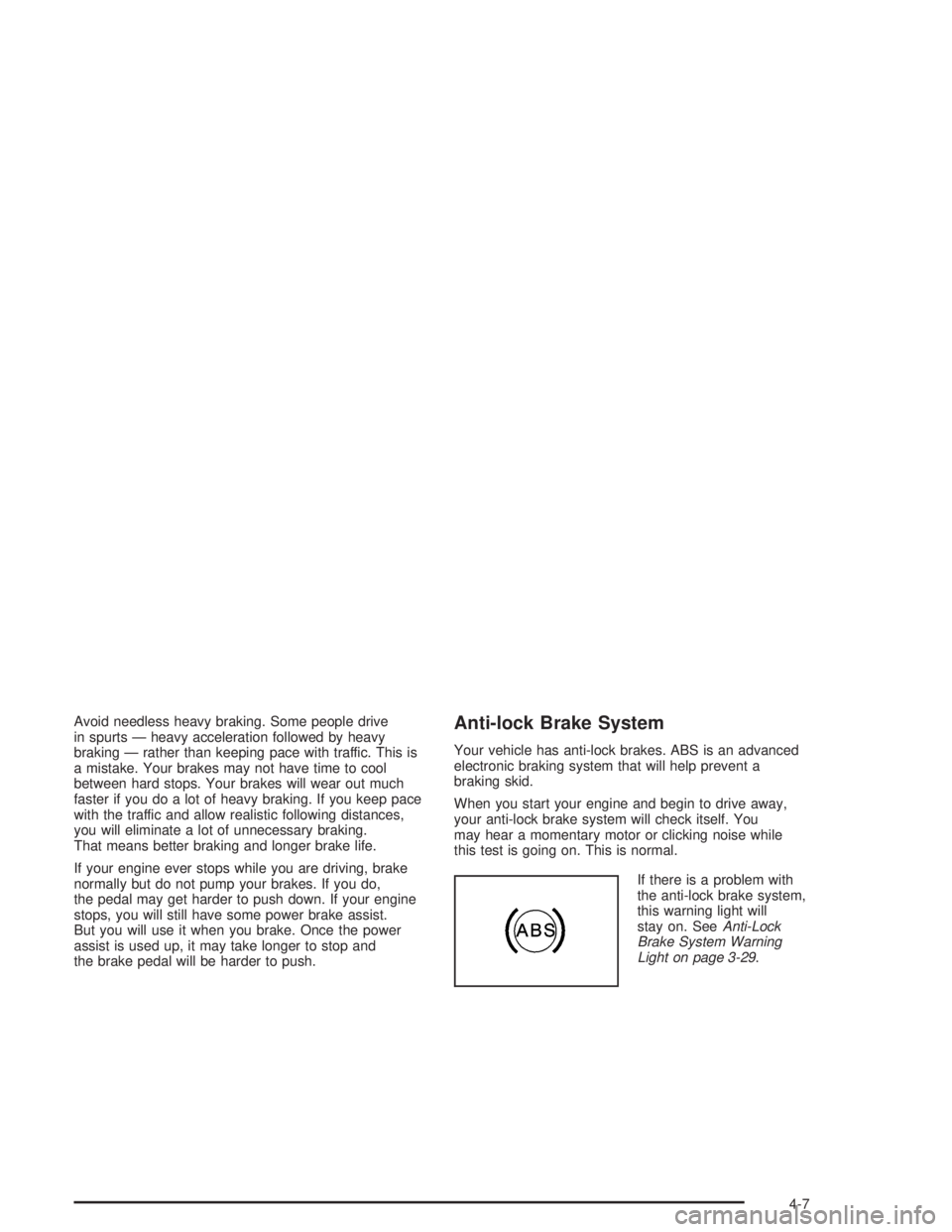
Avoid needless heavy braking. Some people drive
in spurts — heavy acceleration followed by heavy
braking — rather than keeping pace with traffic. This is
a mistake. Your brakes may not have time to cool
between hard stops. Your brakes will wear out much
faster if you do a lot of heavy braking. If you keep pace
with the traffic and allow realistic following distances,
you will eliminate a lot of unnecessary braking.
That means better braking and longer brake life.
If your engine ever stops while you are driving, brake
normally but do not pump your brakes. If you do,
the pedal may get harder to push down. If your engine
stops, you will still have some power brake assist.
But you will use it when you brake. Once the power
assist is used up, it may take longer to stop and
the brake pedal will be harder to push.Anti-lock Brake System
Your vehicle has anti-lock brakes. ABS is an advanced
electronic braking system that will help prevent a
braking skid.
When you start your engine and begin to drive away,
your anti-lock brake system will check itself. You
may hear a momentary motor or clicking noise while
this test is going on. This is normal.
If there is a problem with
the anti-lock brake system,
this warning light will
stay on. SeeAnti-Lock
Brake System Warning
Light on page 3-29.
4-7
Page 225 of 398
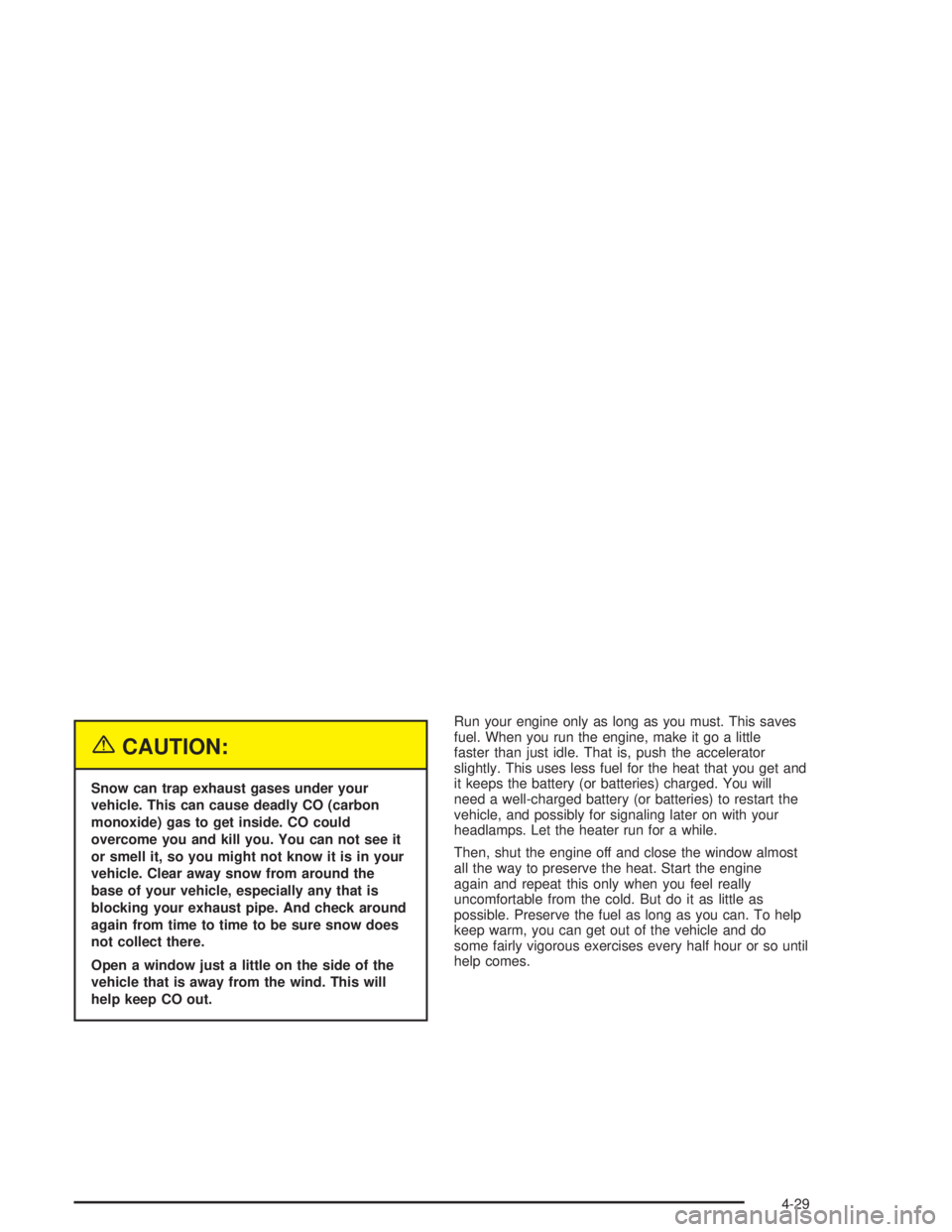
{CAUTION:
Snow can trap exhaust gases under your
vehicle. This can cause deadly CO (carbon
monoxide) gas to get inside. CO could
overcome you and kill you. You can not see it
or smell it, so you might not know it is in your
vehicle. Clear away snow from around the
base of your vehicle, especially any that is
blocking your exhaust pipe. And check around
again from time to time to be sure snow does
not collect there.
Open a window just a little on the side of the
vehicle that is away from the wind. This will
help keep CO out.Run your engine only as long as you must. This saves
fuel. When you run the engine, make it go a little
faster than just idle. That is, push the accelerator
slightly. This uses less fuel for the heat that you get and
it keeps the battery (or batteries) charged. You will
need a well-charged battery (or batteries) to restart the
vehicle, and possibly for signaling later on with your
headlamps. Let the heater run for a while.
Then, shut the engine off and close the window almost
all the way to preserve the heat. Start the engine
again and repeat this only when you feel really
uncomfortable from the cold. But do it as little as
possible. Preserve the fuel as long as you can. To help
keep warm, you can get out of the vehicle and do
some fairly vigorous exercises every half hour or so until
help comes.
4-29
Page 246 of 398
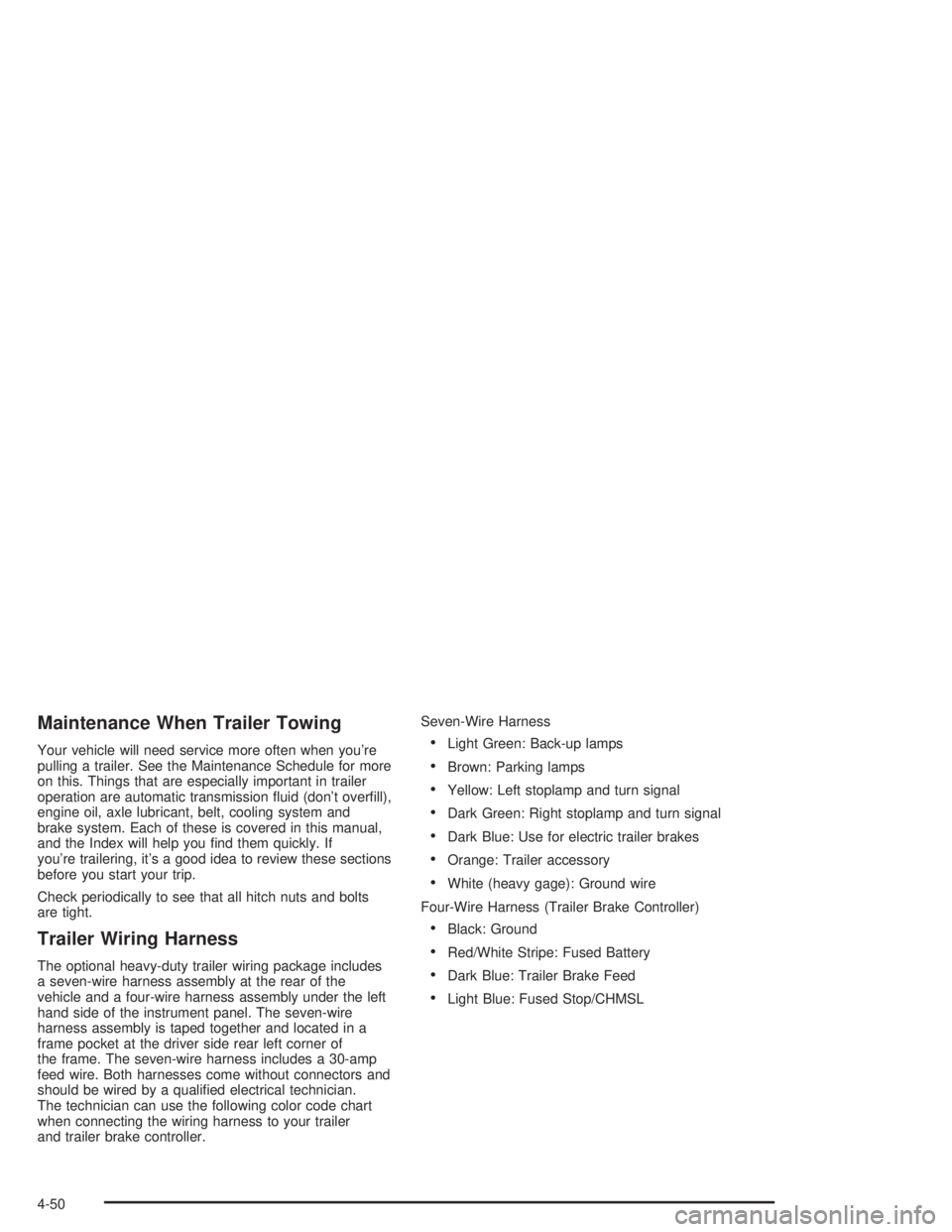
Maintenance When Trailer Towing
Your vehicle will need service more often when you’re
pulling a trailer. See the Maintenance Schedule for more
on this. Things that are especially important in trailer
operation are automatic transmission �uid (don’t over�ll),
engine oil, axle lubricant, belt, cooling system and
brake system. Each of these is covered in this manual,
and the Index will help you �nd them quickly. If
you’re trailering, it’s a good idea to review these sections
before you start your trip.
Check periodically to see that all hitch nuts and bolts
are tight.
Trailer Wiring Harness
The optional heavy-duty trailer wiring package includes
a seven-wire harness assembly at the rear of the
vehicle and a four-wire harness assembly under the left
hand side of the instrument panel. The seven-wire
harness assembly is taped together and located in a
frame pocket at the driver side rear left corner of
the frame. The seven-wire harness includes a 30-amp
feed wire. Both harnesses come without connectors and
should be wired by a quali�ed electrical technician.
The technician can use the following color code chart
when connecting the wiring harness to your trailer
and trailer brake controller.Seven-Wire Harness
Light Green: Back-up lamps
Brown: Parking lamps
Yellow: Left stoplamp and turn signal
Dark Green: Right stoplamp and turn signal
Dark Blue: Use for electric trailer brakes
Orange: Trailer accessory
White (heavy gage): Ground wire
Four-Wire Harness (Trailer Brake Controller)
Black: Ground
Red/White Stripe: Fused Battery
Dark Blue: Trailer Brake Feed
Light Blue: Fused Stop/CHMSL
4-50
Page 262 of 398
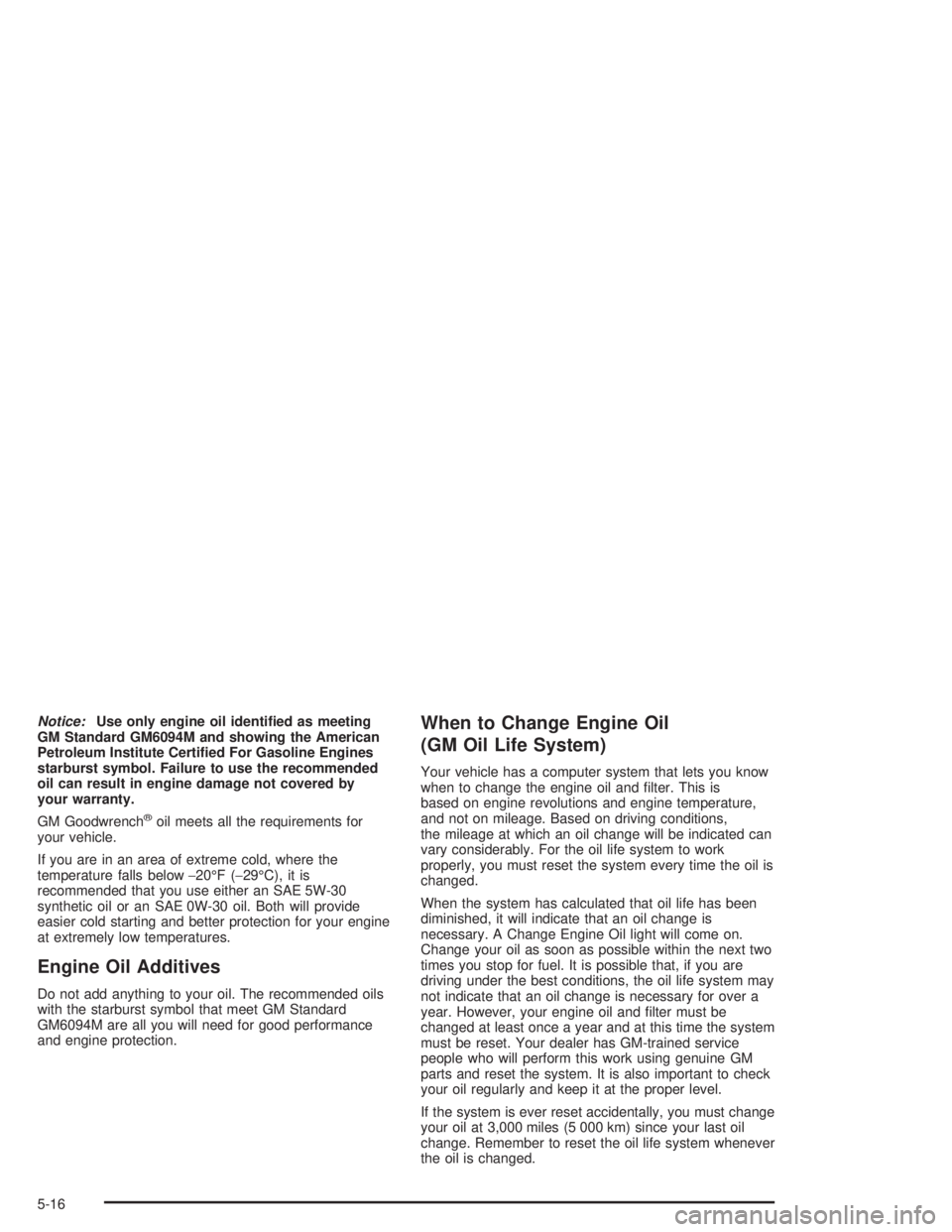
Notice:Use only engine oil identi�ed as meeting
GM Standard GM6094M and showing the American
Petroleum Institute Certi�ed For Gasoline Engines
starburst symbol. Failure to use the recommended
oil can result in engine damage not covered by
your warranty.
GM Goodwrench
®oil meets all the requirements for
your vehicle.
If you are in an area of extreme cold, where the
temperature falls below−20°F (−29°C), it is
recommended that you use either an SAE 5W-30
synthetic oil or an SAE 0W-30 oil. Both will provide
easier cold starting and better protection for your engine
at extremely low temperatures.
Engine Oil Additives
Do not add anything to your oil. The recommended oils
with the starburst symbol that meet GM Standard
GM6094M are all you will need for good performance
and engine protection.
When to Change Engine Oil
(GM Oil Life System)
Your vehicle has a computer system that lets you know
when to change the engine oil and �lter. This is
based on engine revolutions and engine temperature,
and not on mileage. Based on driving conditions,
the mileage at which an oil change will be indicated can
vary considerably. For the oil life system to work
properly, you must reset the system every time the oil is
changed.
When the system has calculated that oil life has been
diminished, it will indicate that an oil change is
necessary. A Change Engine Oil light will come on.
Change your oil as soon as possible within the next two
times you stop for fuel. It is possible that, if you are
driving under the best conditions, the oil life system may
not indicate that an oil change is necessary for over a
year. However, your engine oil and �lter must be
changed at least once a year and at this time the system
must be reset. Your dealer has GM-trained service
people who will perform this work using genuine GM
parts and reset the system. It is also important to check
your oil regularly and keep it at the proper level.
If the system is ever reset accidentally, you must change
your oil at 3,000 miles (5 000 km) since your last oil
change. Remember to reset the oil life system whenever
the oil is changed.
5-16
Page 268 of 398
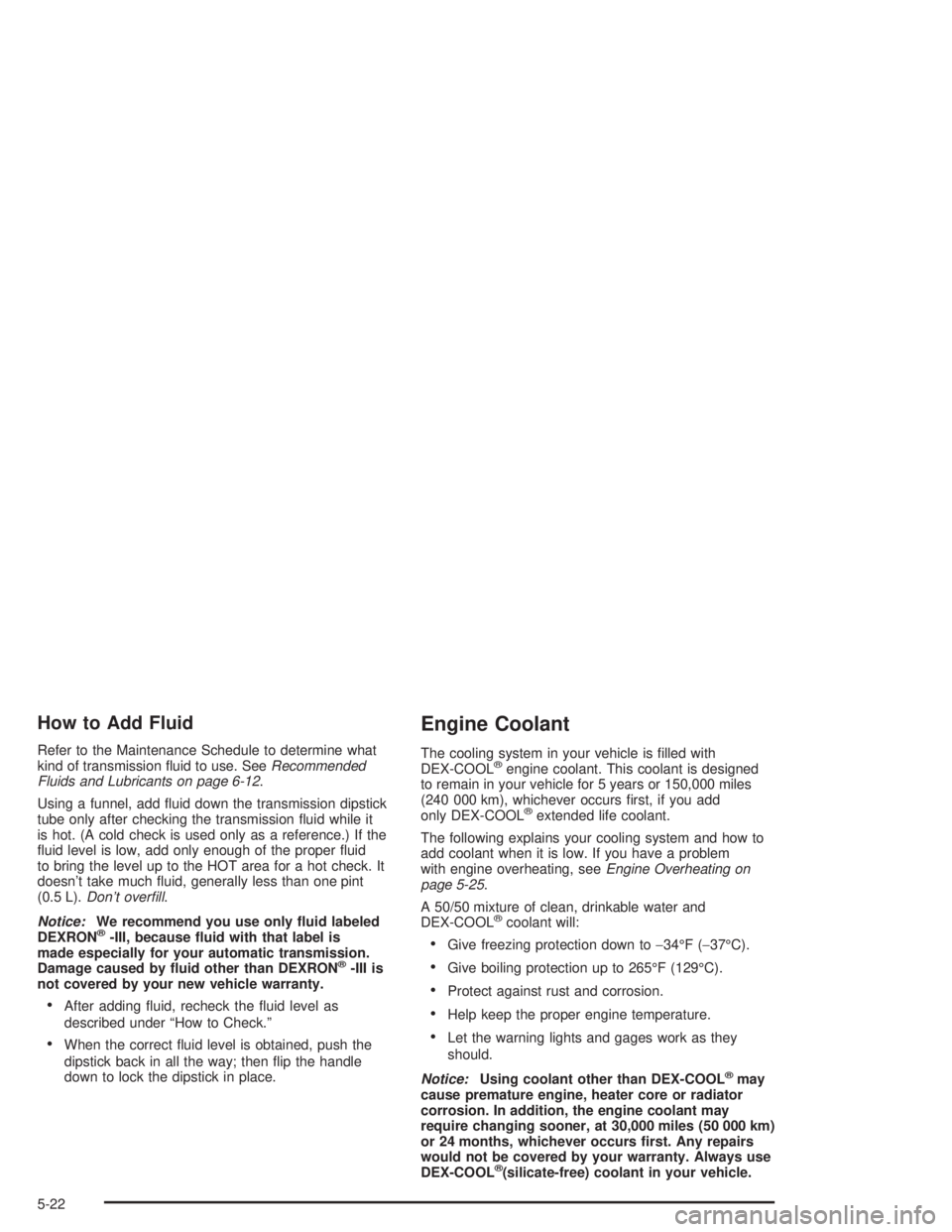
How to Add Fluid
Refer to the Maintenance Schedule to determine what
kind of transmission �uid to use. SeeRecommended
Fluids and Lubricants on page 6-12.
Using a funnel, add �uid down the transmission dipstick
tube only after checking the transmission �uid while it
is hot. (A cold check is used only as a reference.) If the
�uid level is low, add only enough of the proper �uid
to bring the level up to the HOT area for a hot check. It
doesn’t take much �uid, generally less than one pint
(0.5 L).Don’t over�ll.
Notice:We recommend you use only �uid labeled
DEXRON
®-III, because �uid with that label is
made especially for your automatic transmission.
Damage caused by �uid other than DEXRON
®-III is
not covered by your new vehicle warranty.
After adding �uid, recheck the �uid level as
described under “How to Check.”
When the correct �uid level is obtained, push the
dipstick back in all the way; then �ip the handle
down to lock the dipstick in place.
Engine Coolant
The cooling system in your vehicle is �lled with
DEX-COOL®engine coolant. This coolant is designed
to remain in your vehicle for 5 years or 150,000 miles
(240 000 km), whichever occurs �rst, if you add
only DEX-COOL
®extended life coolant.
The following explains your cooling system and how to
add coolant when it is low. If you have a problem
with engine overheating, seeEngine Overheating on
page 5-25.
A 50/50 mixture of clean, drinkable water and
DEX-COOL
®coolant will:
Give freezing protection down to−34°F (−37°C).
Give boiling protection up to 265°F (129°C).
Protect against rust and corrosion.
Help keep the proper engine temperature.
Let the warning lights and gages work as they
should.
Notice:Using coolant other than DEX-COOL
®may
cause premature engine, heater core or radiator
corrosion. In addition, the engine coolant may
require changing sooner, at 30,000 miles (50 000 km)
or 24 months, whichever occurs �rst. Any repairs
would not be covered by your warranty. Always use
DEX-COOL
®(silicate-free) coolant in your vehicle.
5-22
Page 362 of 398
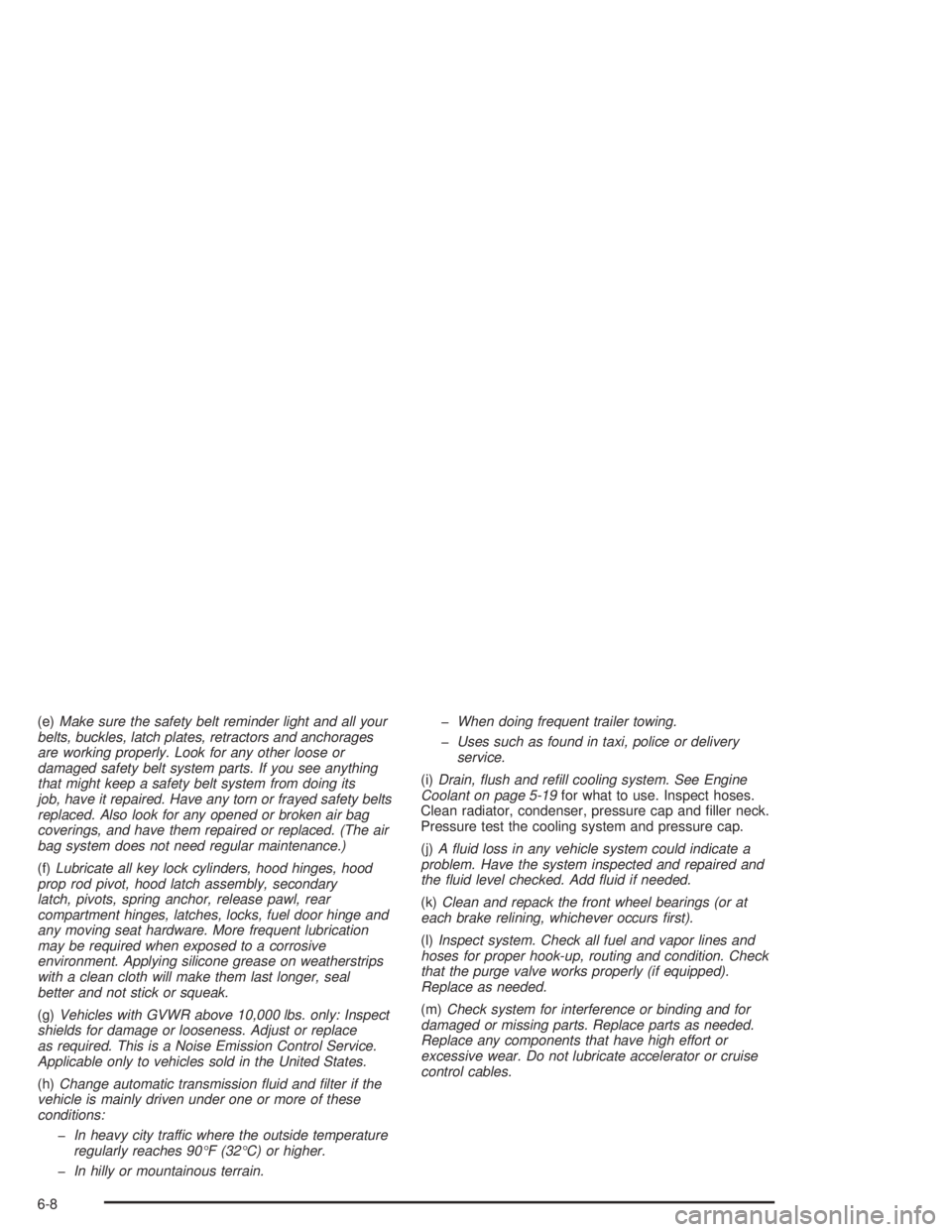
(e)Make sure the safety belt reminder light and all your
belts, buckles, latch plates, retractors and anchorages
are working properly. Look for any other loose or
damaged safety belt system parts. If you see anything
that might keep a safety belt system from doing its
job, have it repaired. Have any torn or frayed safety belts
replaced. Also look for any opened or broken air bag
coverings, and have them repaired or replaced. (The air
bag system does not need regular maintenance.)
(f)Lubricate all key lock cylinders, hood hinges, hood
prop rod pivot, hood latch assembly, secondary
latch, pivots, spring anchor, release pawl, rear
compartment hinges, latches, locks, fuel door hinge and
any moving seat hardware. More frequent lubrication
may be required when exposed to a corrosive
environment. Applying silicone grease on weatherstrips
with a clean cloth will make them last longer, seal
better and not stick or squeak.
(g)Vehicles with GVWR above 10,000 lbs. only: Inspect
shields for damage or looseness. Adjust or replace
as required. This is a Noise Emission Control Service.
Applicable only to vehicles sold in the United States.
(h)Change automatic transmission �uid and �lter if the
vehicle is mainly driven under one or more of these
conditions:
�In heavy city traffic where the outside temperature
regularly reaches 90°F (32°C) or higher.
�In hilly or mountainous terrain.�When doing frequent trailer towing.
�Uses such as found in taxi, police or delivery
service.
(i)Drain, �ush and re�ll cooling system. See Engine
Coolant on page 5-19for what to use. Inspect hoses.
Clean radiator, condenser, pressure cap and �ller neck.
Pressure test the cooling system and pressure cap.
(j)A �uid loss in any vehicle system could indicate a
problem. Have the system inspected and repaired and
the �uid level checked. Add �uid if needed.
(k)Clean and repack the front wheel bearings (or at
each brake relining, whichever occurs �rst).
(l)Inspect system. Check all fuel and vapor lines and
hoses for proper hook-up, routing and condition. Check
that the purge valve works properly (if equipped).
Replace as needed.
(m)Check system for interference or binding and for
damaged or missing parts. Replace parts as needed.
Replace any components that have high effort or
excessive wear. Do not lubricate accelerator or cruise
control cables.
6-8
Page 387 of 398
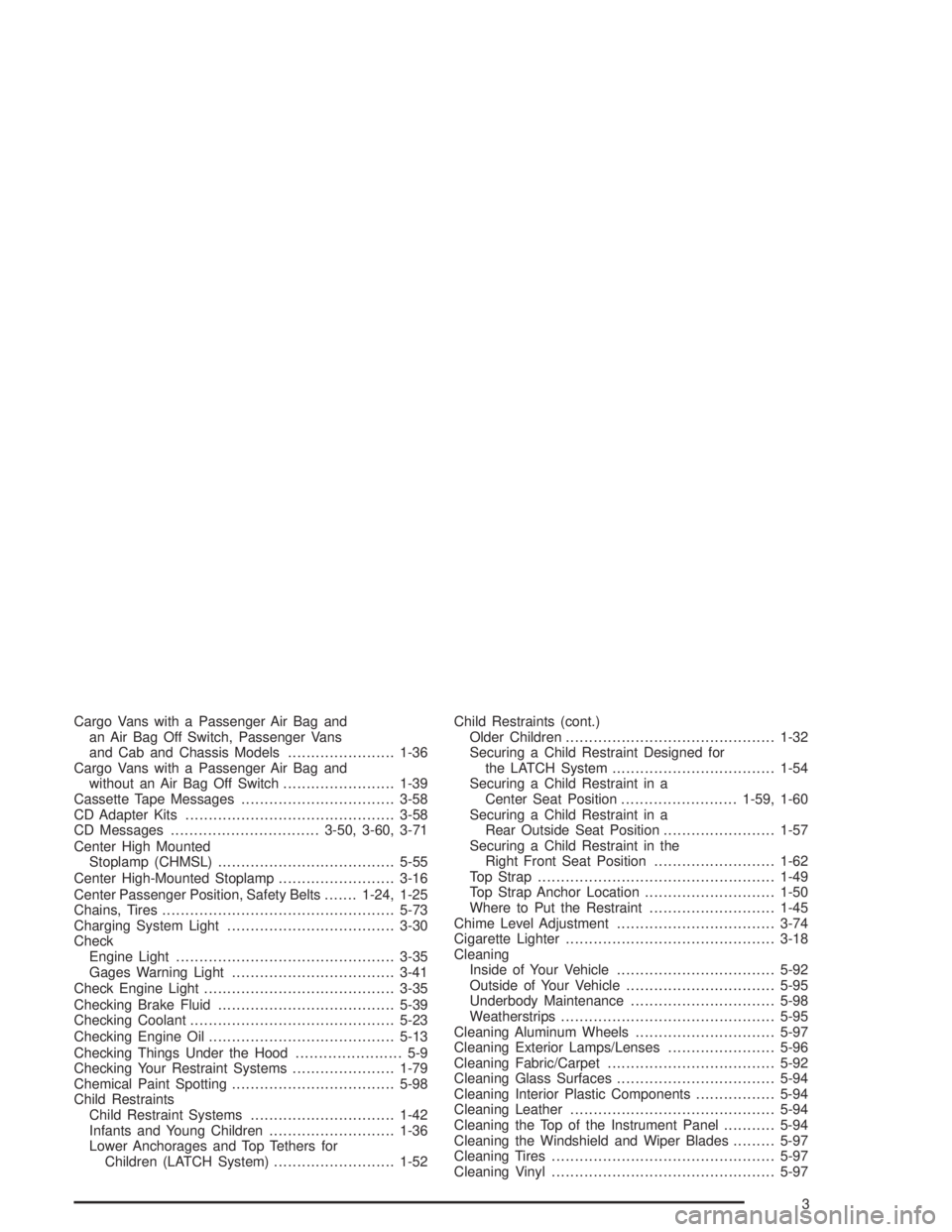
Cargo Vans with a Passenger Air Bag and
an Air Bag Off Switch, Passenger Vans
and Cab and Chassis Models.......................1-36
Cargo Vans with a Passenger Air Bag and
without an Air Bag Off Switch........................1-39
Cassette Tape Messages.................................3-58
CD Adapter Kits.............................................3-58
CD Messages................................3-50, 3-60, 3-71
Center High Mounted
Stoplamp (CHMSL)......................................5-55
Center High-Mounted Stoplamp.........................3-16
Center Passenger Position, Safety Belts.......1-24, 1-25
Chains, Tires..................................................5-73
Charging System Light....................................3-30
Check
Engine Light...............................................3-35
Gages Warning Light...................................3-41
Check Engine Light.........................................3-35
Checking Brake Fluid......................................5-39
Checking Coolant............................................5-23
Checking Engine Oil........................................5-13
Checking Things Under the Hood....................... 5-9
Checking Your Restraint Systems......................1-79
Chemical Paint Spotting...................................5-98
Child Restraints
Child Restraint Systems...............................1-42
Infants and Young Children...........................1-36
Lower Anchorages and Top Tethers for
Children (LATCH System)..........................1-52Child Restraints (cont.)
Older Children.............................................1-32
Securing a Child Restraint Designed for
the LATCH System...................................1-54
Securing a Child Restraint in a
Center Seat Position.........................1-59, 1-60
Securing a Child Restraint in a
Rear Outside Seat Position........................1-57
Securing a Child Restraint in the
Right Front Seat Position..........................1-62
Top Strap...................................................1-49
Top Strap Anchor Location............................1-50
Where to Put the Restraint...........................1-45
Chime Level Adjustment..................................3-74
Cigarette Lighter.............................................3-18
Cleaning
Inside of Your Vehicle..................................5-92
Outside of Your Vehicle................................5-95
Underbody Maintenance...............................5-98
Weatherstrips..............................................5-95
Cleaning Aluminum Wheels..............................5-97
Cleaning Exterior Lamps/Lenses.......................5-96
Cleaning Fabric/Carpet....................................5-92
Cleaning Glass Surfaces..................................5-94
Cleaning Interior Plastic Components.................5-94
Cleaning Leather............................................5-94
Cleaning the Top of the Instrument Panel...........5-94
Cleaning the Windshield and Wiper Blades.........5-97
Cleaning Tires................................................5-97
Cleaning Vinyl................................................5-97
3
Page 389 of 398
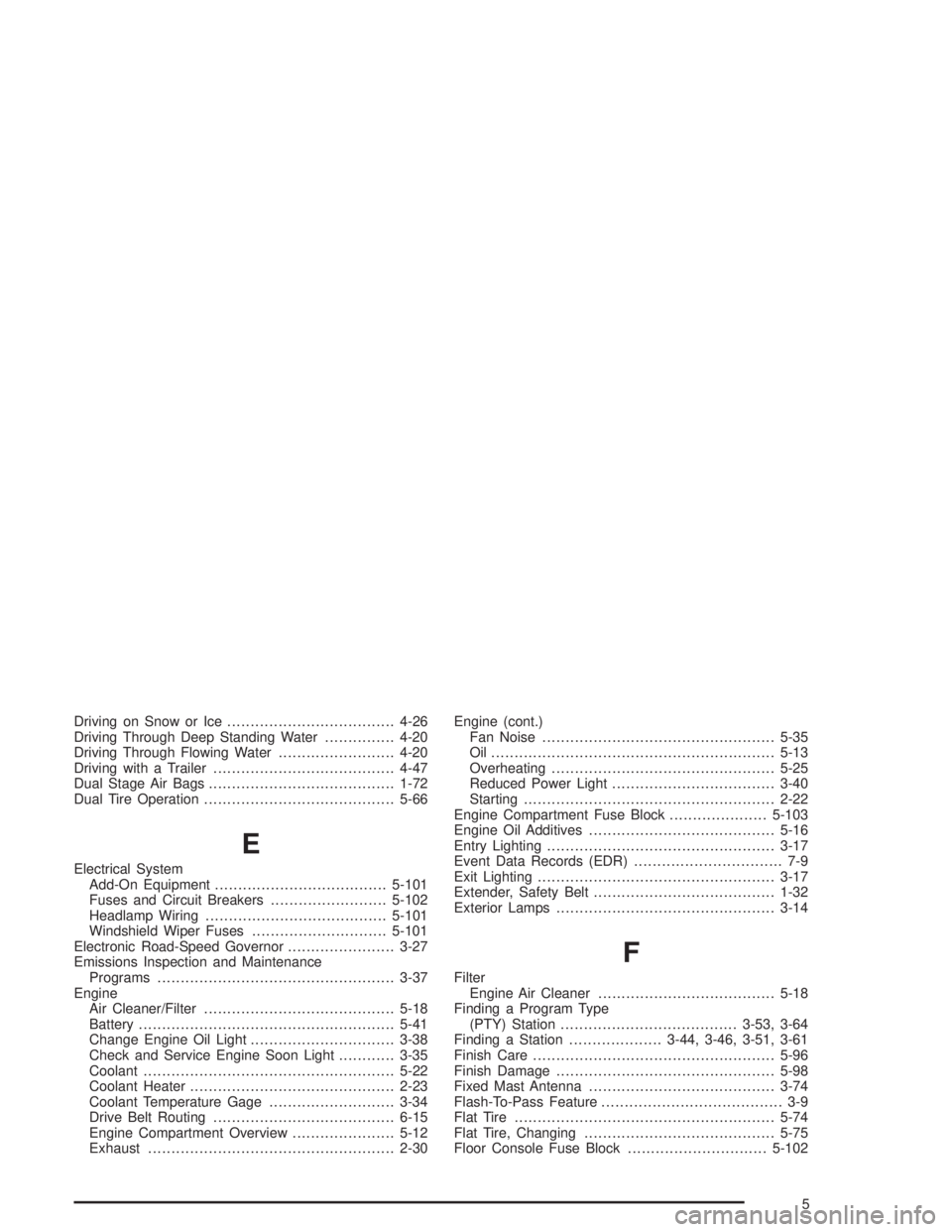
Driving on Snow or Ice....................................4-26
Driving Through Deep Standing Water...............4-20
Driving Through Flowing Water.........................4-20
Driving with a Trailer.......................................4-47
Dual Stage Air Bags........................................1-72
Dual Tire Operation.........................................5-66
E
Electrical System
Add-On Equipment.....................................5-101
Fuses and Circuit Breakers.........................5-102
Headlamp Wiring.......................................5-101
Windshield Wiper Fuses.............................5-101
Electronic Road-Speed Governor.......................3-27
Emissions Inspection and Maintenance
Programs...................................................3-37
Engine
Air Cleaner/Filter.........................................5-18
Battery.......................................................5-41
Change Engine Oil Light...............................3-38
Check and Service Engine Soon Light............3-35
Coolant......................................................5-22
Coolant Heater............................................2-23
Coolant Temperature Gage...........................3-34
Drive Belt Routing.......................................6-15
Engine Compartment Overview......................5-12
Exhaust.....................................................2-30Engine (cont.)
Fan Noise..................................................5-35
Oil .............................................................5-13
Overheating................................................5-25
Reduced Power Light...................................3-40
Starting......................................................2-22
Engine Compartment Fuse Block.....................5-103
Engine Oil Additives........................................5-16
Entry Lighting.................................................3-17
Event Data Records (EDR)................................ 7-9
Exit Lighting...................................................3-17
Extender, Safety Belt.......................................1-32
Exterior Lamps...............................................3-14
F
Filter
Engine Air Cleaner......................................5-18
Finding a Program Type
(PTY) Station......................................3-53, 3-64
Finding a Station....................3-44, 3-46, 3-51, 3-61
Finish Care....................................................5-96
Finish Damage...............................................5-98
Fixed Mast Antenna........................................3-74
Flash-To-Pass Feature....................................... 3-9
Flat Tire........................................................5-74
Flat Tire, Changing.........................................5-75
Floor Console Fuse Block..............................5-102
5
Page 390 of 398
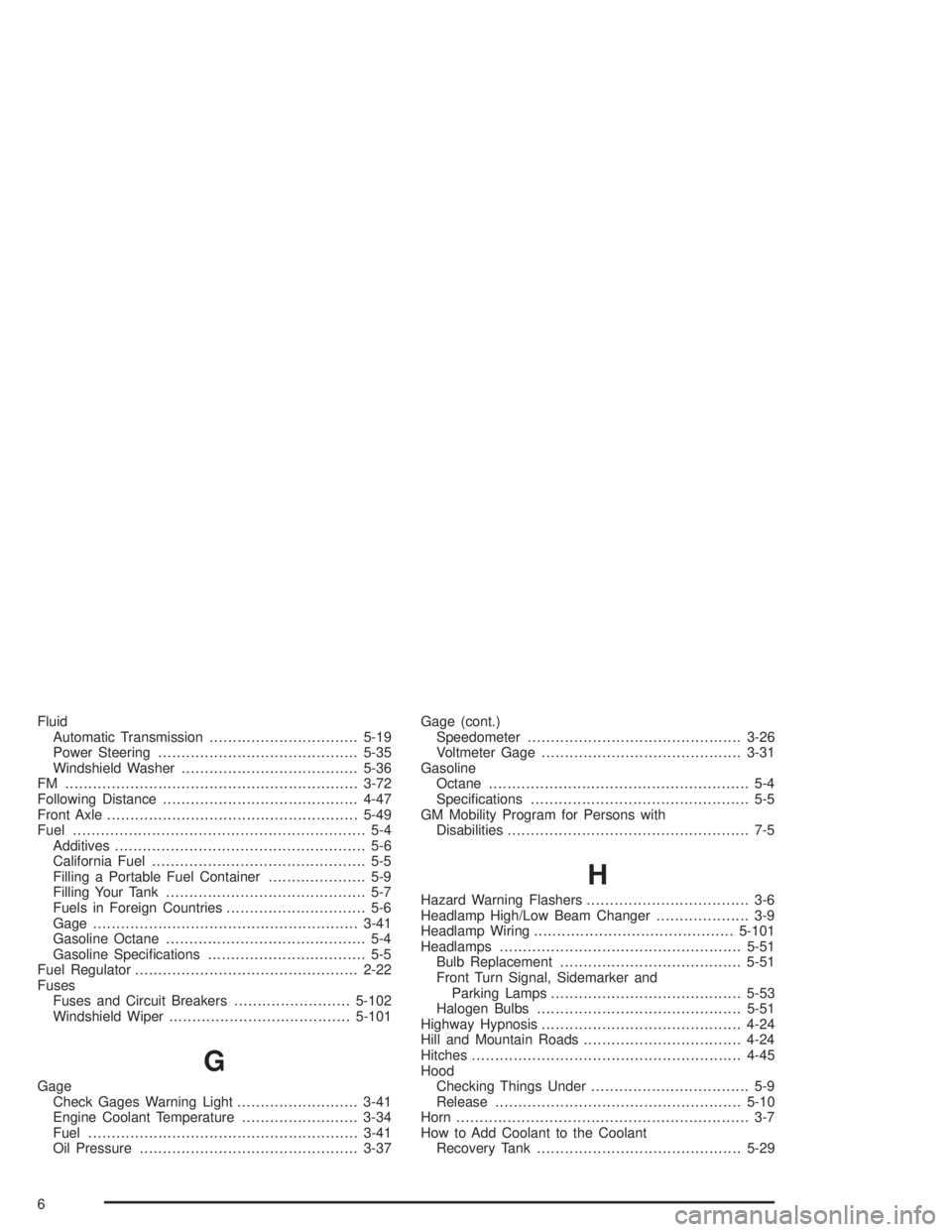
Fluid
Automatic Transmission................................5-19
Power Steering...........................................5-35
Windshield Washer......................................5-36
FM ...............................................................3-72
Following Distance..........................................4-47
Front Axle......................................................5-49
Fuel............................................................... 5-4
Additives...................................................... 5-6
California Fuel.............................................. 5-5
Filling a Portable Fuel Container..................... 5-9
Filling Your Tank........................................... 5-7
Fuels in Foreign Countries.............................. 5-6
Gage.........................................................3-41
Gasoline Octane........................................... 5-4
Gasoline Speci�cations.................................. 5-5
Fuel Regulator................................................2-22
Fuses
Fuses and Circuit Breakers.........................5-102
Windshield Wiper.......................................5-101
G
Gage
Check Gages Warning Light..........................3-41
Engine Coolant Temperature.........................3-34
Fuel..........................................................3-41
Oil Pressure...............................................3-37Gage (cont.)
Speedometer..............................................3-26
Voltmeter Gage...........................................3-31
Gasoline
Octane........................................................ 5-4
Speci�cations............................................... 5-5
GM Mobility Program for Persons with
Disabilities.................................................... 7-5
H
Hazard Warning Flashers................................... 3-6
Headlamp High/Low Beam Changer.................... 3-9
Headlamp Wiring...........................................5-101
Headlamps....................................................5-51
Bulb Replacement.......................................5-51
Front Turn Signal, Sidemarker and
Parking Lamps.........................................5-53
Halogen Bulbs............................................5-51
Highway Hypnosis...........................................4-24
Hill and Mountain Roads..................................4-24
Hitches..........................................................4-45
Hood
Checking Things Under.................................. 5-9
Release.....................................................5-10
Horn............................................................... 3-7
How to Add Coolant to the Coolant
Recovery Tank............................................5-29
6
Page 391 of 398
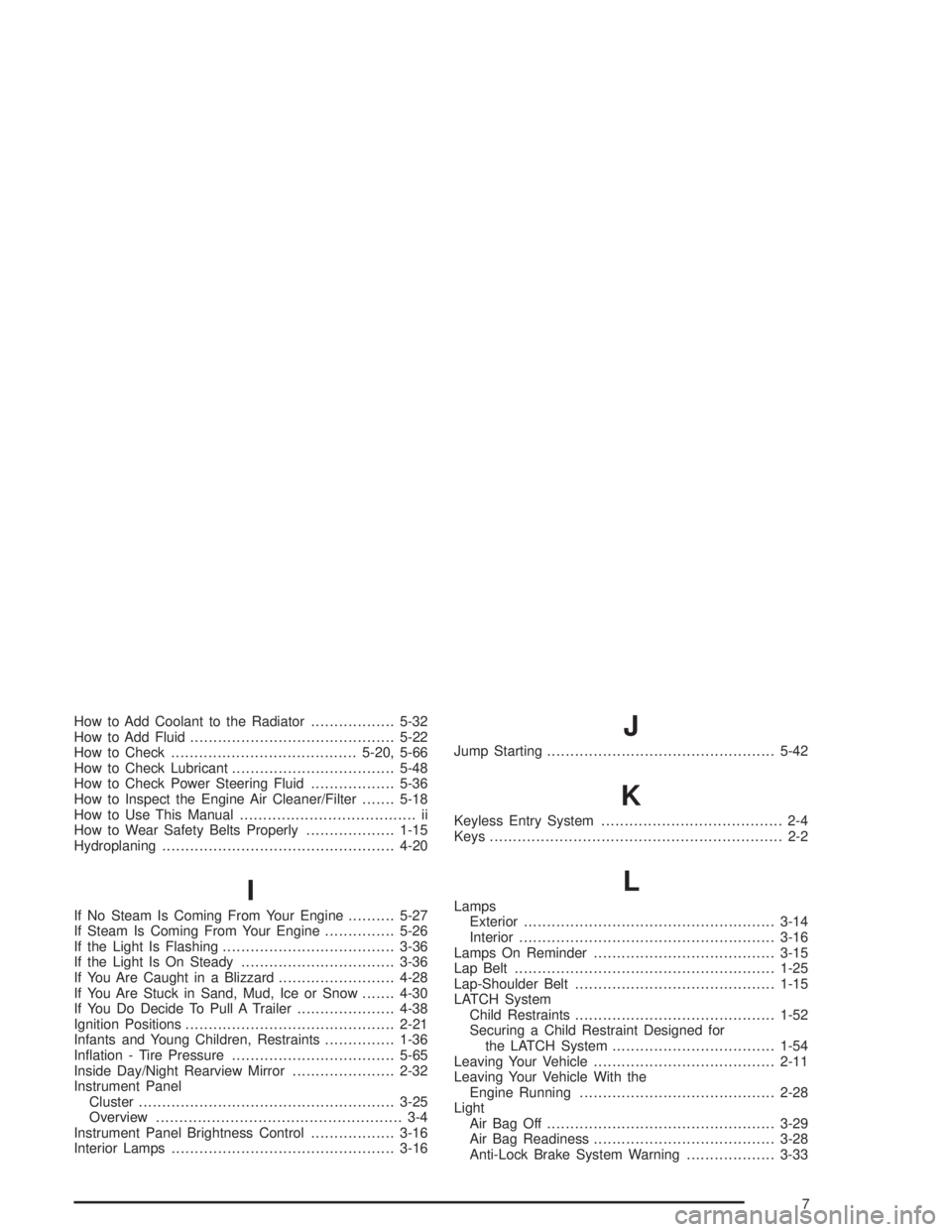
How to Add Coolant to the Radiator..................5-32
How to Add Fluid............................................5-22
How to Check........................................5-20, 5-66
How to Check Lubricant...................................5-48
How to Check Power Steering Fluid..................5-36
How to Inspect the Engine Air Cleaner/Filter.......5-18
How to Use This Manual...................................... ii
How to Wear Safety Belts Properly...................1-15
Hydroplaning..................................................4-20
I
If No Steam Is Coming From Your Engine..........5-27
If Steam Is Coming From Your Engine...............5-26
If the Light Is Flashing.....................................3-36
If the Light Is On Steady.................................3-36
If You Are Caught in a Blizzard.........................4-28
If You Are Stuck in Sand, Mud, Ice or Snow.......4-30
If You Do Decide To Pull A Trailer.....................4-38
Ignition Positions.............................................2-21
Infants and Young Children, Restraints...............1-36
In�ation - Tire Pressure...................................5-65
Inside Day/Night Rearview Mirror......................2-32
Instrument Panel
Cluster.......................................................3-25
Overview..................................................... 3-4
Instrument Panel Brightness Control..................3-16
Interior Lamps................................................3-16
J
Jump Starting.................................................5-42
K
Keyless Entry System....................................... 2-4
Keys............................................................... 2-2
L
Lamps
Exterior......................................................3-14
Interior.......................................................3-16
Lamps On Reminder.......................................3-15
Lap Belt........................................................1-25
Lap-Shoulder Belt...........................................1-15
LATCH System
Child Restraints...........................................1-52
Securing a Child Restraint Designed for
the LATCH System...................................1-54
Leaving Your Vehicle.......................................2-11
Leaving Your Vehicle With the
Engine Running..........................................2-28
Light
Air Bag Off .................................................3-29
Air Bag Readiness.......................................3-28
Anti-Lock Brake System Warning...................3-33
7